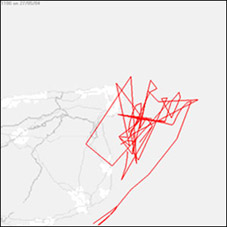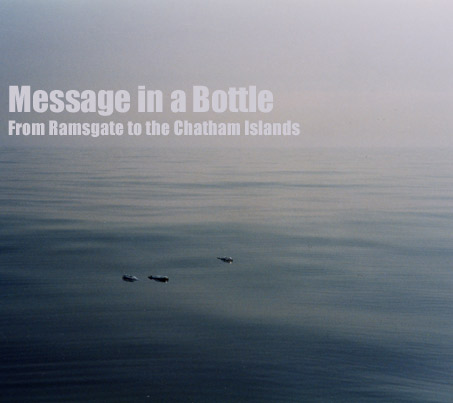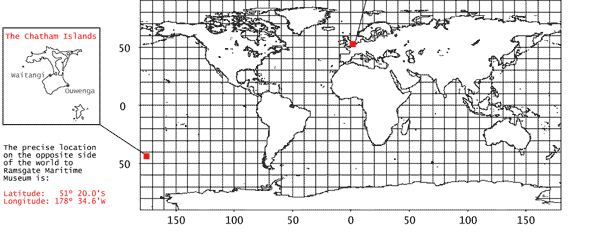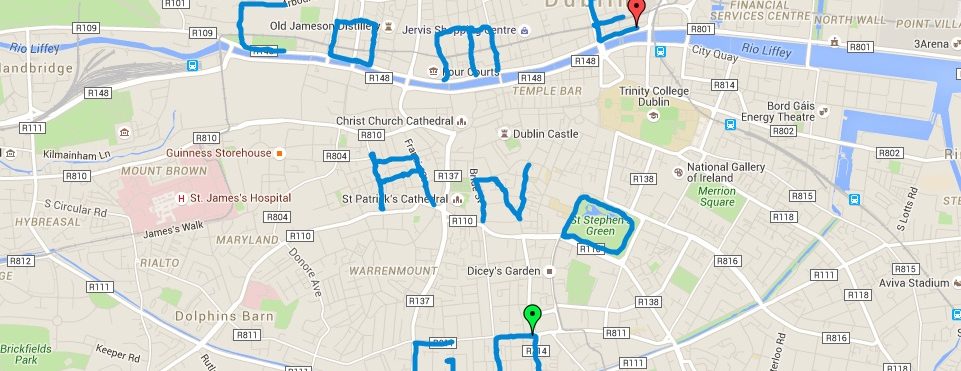Locative Projects
1. Message in a Bottle

Alguns projetos e post interessantes sobre locative media. O primeiro é o projeto Message in a Bottle, usando garrafas jogadas ao mar com GPS permitindo que pessoas que as achem possam colocar novas mensagens e jogá-las de novo ao seu caminho. O trajeto monitorado e esperado é de Ramsgate à Chatam Islands, no Pacífico. Vejam descrição:

“On 25th May 2004, fifty bottles containing messages were released into the sea off the south-east coast of England near Ramsgate Maritime Museum, Kent. The intended destination of the bottles is The Chatham Islands in the South Pacific Ocean. The islands, which are 800km east of mainland New Zealand, are the nearest inhabited land to the precise location on the opposite side of the world to Ramsgate Maritime Museum. It is anticipated that the bottles may be found several times before reaching the Chatham Islands.

If you have found a message in a bottle please report it here.
Once you have reported finding the bottle please replace all of the bottle’s contents, reseal the bottle and release it back into the sea to continue its journey
to The Chatham Islands……

Several of the bottles are being tracked using GPS technology and are programmed to send their longitude and latitude coordinates back to Ramsgate every hour. The information they transmit is used to create a real time drawing of their progress.”
Each non-GPS bottle contains a message from residents of Ramsgate to the residents of The Chatham Islands, a pencil and an instruction leaflet which requests anyone finding a bottle to report to this website and record where and when the bottle was found. In addition they are requested to document their find on
a form inside the bottle before returning the bottle to the sea to continue its journey. Details of found bottles may be viewed on the view found bottles page.”
2. Locative Media Art
Um pdf com vários projetos/links sobre Arte e Locative Media, disponível aqui, via Social Interface.
3. Território de Sentido
Esse post faz referência ao mScape da HP e como o autor reforça a idéia de um território informacional, mesmo sem usar esses termos. Abaixo vídeo do mScape (via NewMW):
“I recently stumbled upon mScape, the new Hewlett Packard software, which allows you to create generative locative media experience. It really allows you to tailor a virtual space to the territory and give new meaning to it. A toolkit for the locative future? This YouTube presentation video gives you a sense of what the tool can do.”
4.Starbuck Urbanismo
Post do evento The Mobile City esquenta para o encontro em fevereiro em Roterdã. O post mostra, como hipótese, a passagem de um urbanismo de espaços públicos onde a opinião se dava em alamedas, ruas, praças e cafés e praças, para um outro tipo em que impera a conexão em territórios informacionais nos novos “cibercafés” (Second Cup, Starbucks e similares) que oferecem, hoje em dia, conexão à internet, sem fio. Estes seriam (não)lugares (placeless) mais de acesso informacional externo do que de contato direto com outros usuários, diminuindo o sentimento de espaço público e de lugar. Questionamos essa idéia de não lugar e placeless em outro post. Algumas pesquisa (Ito, por exemplo) questionam essa visão. Acho que, sem desenvolver muito agora, se a esfera burguesa e o espaço público habermasiano foi exagerado na sua potência de lugar público e de opinião pública (pelo próprio Habermas e seguidores), o mesmo parece acontecer agora com os “cibercafés”, exagerando na potência individualista dos mesmos. Aqui no Canadá, como nos EUA, o ambiente é realmente muito diferente dos cafés europeus, mas os contatos e as conversas acontecem, e muitos lêem seus jornais sem abrir um laptop ou o smartphone.
Abaixo trechos:

“Over Christmas I reviewed some literature on locative media, and came across a handful of texts that addressed the changing role of the coffee house in our urban culture. Perhaps we are seeing a paradigm shift here: away from a BLVD-urbanism of public culture and towards a Starbucks Urbanism of a networked culture?
Kazys Varnelis and Anne Friedberg interesting essay Place: Networked Place starts with a descriptive ‘scene from Starbucks’. This is not your great-grandfather’s coffeehouse, found on a tree-lined European Boulevard with an outside terrace. It is no longer the coffeehouses that functioned as the proverbial meeting place or ‘public sphere’ where citizens irrespective of their background (as long as they wern’t women or other excluded groups that Habermas in his theory on the emerging public sphere overlooked) could engage in discussion with one another.
‘The café, and the rituals of coffee and caffeine that grew along with it, provided both forum and fuel for critical debate about the latest pamphlets, newsletters and broadsides. But the public sphere was not primarily a physical place, rather it was a discursive site where a literate public could conduct rational and critical debate. The assembly and dialogue that constituted this emerging public sphere occurred as much within the pages of newly circulated printed materials as it did within the walls of the coffeehouse.’
In Starbucks people congregate not so much to communicate with one another. Rather they use it as a comfortable semi-public base from which they keep in touch with their personal friends or collegues through the 3 and 4-letter acronyms that make up our network society: GSM, SMS, UMTS, WIFI. As Marc Tuters writes in another key essay on locative media, this emerging Starbucks culture has often been described as antithetical to the public culture of the coffeehouses.
‘By contrast today’s ubiquitous Starbucks cappuccino bars offer the digital, mobile class a refuge from the pace of city, a space of introspection rather than random encounter. [these places] … form an archipelago of pseudo public spaces throughout the world’s cities. Particularly in the post-911 world, the function of these places to provide random encounter is practically eliminated in these insulted pay-access locations under the operative logic of ‘risk aversion’. Based on these observations, sociologists and urban theorists have developed a narrative of loss and decline in the contemporary literature on public space — Zukin (1991), Sorkin (1992), Hannigan (1998), in which contemporary public spaces are characterized theme parks, or walled gardens'(…)”.
5. Abstract do texto “Portable Objects in Three Global Cities: The Personalization of Urban Places”
The abstract: “The mobile phone has become the central node of the ensemble of portable objects that urbanites carry with them as they negotiate their way through information-rich global cities. This paper reports on a study conducted in Tokyo, Los Angeles, and London where we tracked young professionals use of the portable objects. By examining devices such as music players, credit cards, transit cards, keys, and ID cards in addition to mobile phones, this study seeks to understand how portable devices construct and support an individual’s identity and activities, mediating relationships with people, places, and institutions. Portable informational objects reshape and personalize the affordances of urban space. Laptops transform cafés into personal offices. Reward and membership cards keep track of individuals’ use of urban services. Music players and mobile devices colonize the in-between times of waiting and transit with the logic of personal communications and media consumption. Our focus in this paper is not on the relational communication that has been the focus of most mobile communication studies, but rather on how portable devices mediate relationships to urban space and infrastructures. We identify three genres of presence in urban space that involve the combination of portable media devices, people, infrastructures, and locations: cocooning, camping, and footprinting. These place-making processes provide hints to how portable devices have reshaped the experience of space and time in global cities.”
